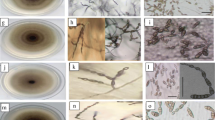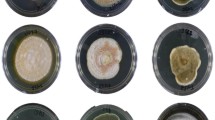Abstract
Tomato leaves showing severe leaf spot symptoms have been observed and sampled in the central west and southwest Taiwan during 2015 and 2016. The symptoms were similar to those of bacterial leaf spot/late blight diseases, but only Stemphylium-like fungi were consistently isolated from the diseased tomato. Upon spray inoculation of tomato, Stemphylium-like isolates caused leaf spot symptoms identical to those of naturally infected plants, and the pathogenic isolates were successfully re-isolated from inoculated leaves. The tomato-pathogenic isolates were identified as S. lycopersici based on morphological characterization and molecular identification. S. lycopersici has been previously reported to cause gray leaf spot of tomato in the temperate regions, but the majority of S. lycopersici-caused lesions were black/dark brown rather than gray in our surveillance. Accordingly, it is suggested that S. lycopersici-caused disease of tomato is named Stemphylium leaf spot of tomato more appropriately than tomato gray leaf spot. Moreover, S. lycopersici-caused leaf spot disease on tomato has been distributed in major tomato production regions in Taiwan. The information provided by our study will be important for future breeding of tomato cultivars, especially for tomato producers in Taiwan.






Similar content being viewed by others
References
Bashi, E., Pilowski, M., & Rotem, J. (1973). Resistance in tomatoes to Stemphylium floridanum and S. botryosum f. Sp. lycopersici. Phytopathology, 63, 1542–1544.
Behare, J., Laterrot, H., Sarfatti, M., & Zamir, D. (1991). Restriction fragment length polymorphism mapping of the Stemphylium resistance gene in tomato. Molecular Plant-Microbe Interactions, 4, 489–492.
Blancard, D., & Laterrot, H. (1986). Les Stemphylia rencontres sur tomate. Phytopathol. Medit., 25, 140–144.
Camara, M. P. S., O'Neill, N. R., & van Berkum, P. (2002). Phylogeny of Stemphylium spp. based on ITS and glyceraldehyde-3-phosphate dehydrogenase gene sequences. Mycologia, 94, 660–672.
Campos, M. L., Carvalho, R. F., Benedito, V. A., & Peres, L. E. P. (2010). Small and remarkable: the micro-Tom model system as a tool to discover novel hormonal functions and interactions. Plant Signaling & Behavior, 5, 267–270.
Cedeno, L., & Carrero, C. (1997). First report of tomato gray leaf spot caused by Stemphylium solani in the Andes region of Venezuela. Plant Disease, 81, 1332.
Cho, H. J., Kim, B. S., & Hwang, H. S. (2001). Resistance to gray leaf spot in Capsicum peppers. Hortscience, 36, 752–754.
Gourley, C. O. (1971). Natural infection of tomato foliage by Pleospora herbarum. Canadian Plant Disease Survey, 51, 135–137.
Hosen, M. I., Ahmed, A. U., Zaman, J., Ghosh, S., & Hossain, K. M. K. (2009). Cultural and physiological variation between isolates of Stemphylium botryosum the causal of Stemphylium blight disease of lentil (Lens culinaris). World J. Agric. Sci., 5, 94–98.
Hsu, S. T. (2002). List of plant disease in Taiwan. Taichung, Taiwan: The Phytopathological Society of the Republic of China.
Inderbitzin, P., Mehta, Y. R., & Berbee, M. L. (2009). Pleospora species with Stemphylium anamorphs: a four locus phylogeny resolves new lineages yet does not distinguish among species in the Pleospora herbarum clade. Mycologia, 101, 329–339.
Jones, J. B., Zitter, T. A., Momol, T. M., & Miller, S. A. (2014). Compendium of tomato diseases and pests (Second ed.). St. Paul, Minnesota: APS Press.
Jyan, M. H., Liou, R. F., Ann, P. J., Tsai, J. N., Hsih, S. D., & Chang, T. T. (2004). Recent occurrence of Phytophthora infestans US-11 as the cause of severe late blight on potato and tomato in Taiwan. Canadian Journal of Plant Pathology, 26, 188–192.
Kim, B. S., Cho, H. J., Hwang, H. S., & Cha, Y. S. (1999). Gray leaf spot of tomato caused by Stemphylium solani. Plant Pathology Journal, 15, 348–350.
Kim, B. S., Yu, S. H., Cho, H. J., & Hwang, H. S. (2004). Gray leaf spot in peppers caused by Stemphylium solani and S. lycopersici. Plant Pathol. J., 20, 85–91.
Kurose, D., Misawa, T., Suzui, T., Ichikawa, K., Kisaki, G., Hoang, L. H., et al. (2015). Taxonomic re-examination of several Japanese Stemphylium strains based on morphological and molecular phylogenetic analyses. Journal of General Plant Pathology, 81, 358–367.
Lin, C. H., Wang, J. F., Wu, T. F., & Cheng, A. H. (2015). Phylotype II race 3 biovar 2 strain of Ralstonia solanacearum in Taiwan: survival potential and virulence on tomato, eggplant, and pepper. Acta Horticulturae, 1069, 293–300.
Nasehi, A., Kadir, J.-B., Nasr-Esfahani, M., Abed-Ashtiani, F., Wong, M. Y., Rambe, S.-K., et al. (2014). Analysis of genetic and virulence variability of Stemphylium lycopersici associated with leaf spot of vegetable crops. European Journal of Plant Pathology, 140, 261–273.
Saitoh, K., Togashi, K., Arie, T., & Teraoka, T. (2006). A simple method for a mini-preparation of fungal DNA. Journal of General Plant Pathology, 72, 348–350.
Sawada, K. (1931). Descriptive catalogue of the Formosan fungi, Part 5 (Vol. 5). Taipei, Taiwan: Department of Agriculture, Government Research Institute, Formosa.
Scott, J., & Harbaugh, B. (1989). Micro-Tom a miniature dwarf tomato. Florida Agr. Exp. Sta.Circ., 370, 1–6.
Sun, X.-T., Zhang, L., Zhang, J.-Z., & Lu, G. (2016). First report of tomato gray leaf spot caused by Stemphylium lycopersici in Zhejiang Province. China. Plant Dis., 100, 227.
Tamura, K., Stecher, G., Peterson, D., Filipski, A., & Kumar, S. (2013). MEGA6: molecular evolutionary genetics analysis version 6.0. Molecular Biology and Evolution, 30, 2725–2729.
Tomioka, K., & Sato, T. (2011). Fruit rot of sweet pepper caused by Stemphylium lycopersici in Japan. Journal of General Plant Pathology, 77, 342–344.
Tsai, W. S., Shih, S. L., Kenyon, L., Green, S. K., & Jan, F. J. (2011). Temporal distribution and pathogenicity of the predominant tomato-infecting begomoviruses in Taiwan. Plant Pathology, 60, 787–799.
Tsai, W. S., Kenyon, L., Hanson, P., Shih, S. L., & Jan, F. J. (2013). Tomato leaf curl disease in Taiwan and breeding for resistance against it. Plant Pathol. Bull., 22, 327–337.
Weber, G. F. (1930). Gray leaf spot of tomato caused by Stemphylium solani sp. nov. Phytopathology, 20, 513–518.
White, T. J., Bruns, T., Lee, S., & Taylor, J. (1990). Amplification and direct sequencing of fungal ribosomal RNA genes for phylogenetics. In M. A. Innis, D. H. Gelfand, J. J. Sninsky, & T. J. White (Eds.), PCR protocols a guide to methods and applications (pp. 315–322). San Diego, CA, USA: Academic Press.
Acknowledgments
This work was financed by the Ministry of Science and Technology, Taiwan, R.O.C.
Authors’ contributions
C.J.H. and W.S.T. conceived this work. C.J.H. designed and carried out most of the experiments. C.J. H analyzed the data and wrote the manuscript. W.S. T was involved in data analysis and revised the manuscript critically. All authors have approved the final version of manuscript.
Author information
Authors and Affiliations
Corresponding author
Ethics declarations
Conflict of interest
The authors declare that they have no conflict of interest.
Rights and permissions
About this article
Cite this article
Huang, CJ., Tsai, WS. Occurrence and identification of Stemphylium lycopersici causing Stemphylium leaf spot disease on tomato in Taiwan. Eur J Plant Pathol 148, 35–44 (2017). https://doi.org/10.1007/s10658-016-1066-8
Accepted:
Published:
Issue Date:
DOI: https://doi.org/10.1007/s10658-016-1066-8




